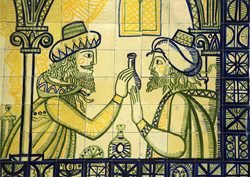A new look at Islam in Medieval Europe
When most of Europe was going through upheaval in the Middle Ages, Andalusia in southern Spain was flourishing academically, scientifically and artistically under Islamic rule. Sophisticated pottery emerged in the region, its design being influenced by the social events of that time. The EU-funded project 'Archaeological research on Andalusian pottery (8th-11th centuries)' (ARANPOT) worked on identifying ceramic patterns and interpreting their significance in today's context.From a technical perspective, the team studied the composition, glazing techniques, manufacture, chemical analysis and petrography of the ceramics, including the provenance of raw materials in glazing. It then extrapolated society's development in the Granada area based on the results of the pottery study, comparing it with other European and Mediterranean models of social development.After intense petrographic analysis and neutron activation analysis, the emerging chemical data yielded in-depth understanding of compositional variability, especially in the fine ware ceramics. The project led to the publication of papers in both English and Spanish that are opening new horizons in Andalusian archaeology, as well as in Islamic and Medieval archaeology.The topic is being published in the Oxford Journal of Archaeology, revealing two distinct patterns of Islamisation and two separate social conceptions of Islam in early Medieval Vega de Granada. These intriguing results and their implications were presented at different archaeology-related events in Europe. The project team has also taken this kind of archaeological analysis to different parts of the Mediterranean and has worked on pottery retrieved from different sites in Palestine.These new theoretical and methodological perspectives can have a strong socioeconomic impact, considering Islam from its material cycle of production, distribution and consumption, even beyond pottery. This helps academia study a cultural division that was not so acutely perceived in the early Medieval period, bringing forth common origins and mutual influences of Europe and Islam.The idea of Europe and Islam as interlinked historical entities is a strong one that citizens and policymakers can exploit. This is particularly important as more Muslim citizens are becoming part of a greater Europe. Ultimately, it could give Europe a stronger role as a balancing power in the Mediterranean region, bringing closer cultural ties with Muslim nations. Perceiving heritage as a common denominator will help undermine fundamentalism on both sides. At the end of the day, Europe with an Islamic past is not a lesser but a greater Europe. If history is portrayed in this light, conflict and radicalism could one day have less of a reason to exist, encouraging peace and coexistence instead.
Keywords
Andalusian pottery, Islamisation, Medieval Europe, Muslim world, ceramics, archaeology, history, fundamentalism



